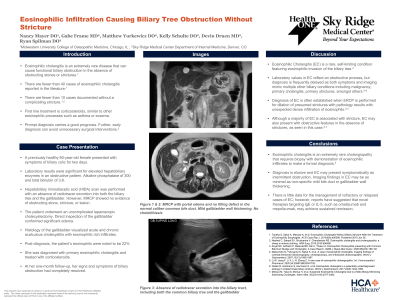Back


Poster Session B - Monday Morning
Category: Biliary/Pancreas
B0075 - Eosinophilic Infiltration Causing Biliary Tree Obstruction Without Stricture
Monday, October 24, 2022
10:00 AM – 12:00 PM ET
Location: Crown Ballroom

Has Audio

Nancy Mayer, DO
Midwestern University
Chicago, IL
Presenting Author(s)
Gabriel Frame, MD1, Nancy Mayer, DO2, Kelly Schulte, DO, MA1, Devin Druen, MD1, Dmitriy Scherbak, DO1
1HCA HealthONE, Lone Tree, CO; 2Midwestern University, Chicago, IL
Introduction: We present an exceedingly rare case of eosinophilic cholangitis (EC) without stricture. Of the 40 cases of EC reported in the literature, fewer than 10 cases did not involve a stricture.
Case Description/Methods: A 60-year-old female with no significant past medical history presented with symptoms of biliary colic for two days. Laboratory results were significant for elevated hepatobiliary enzymes including alkaline phosphatase of 300 IU/L and total bilirubin of 3.8 mg/dL. A hepatobiliary iminodiacetic acid scan was performed with an absence of radiotracer excretion into the biliary tract. However, a magnetic resonance cholangiopancreatography showed no obstructing stone, stricture, or lesion. A broad workup including hepatitis and autoimmune serologies was negative. The patient underwent an uncomplicated laparoscopic cholecystectomy, and direct inspection of the gallbladder confirmed significant edema. Histopathology of the gallbladder showed acute and chronic acalculous cholecystitis with eosinophilic rich infiltrates. Notably, the patient had an absolute eosinophil count of 1.2 cells/µL. She was diagnosed with eosinophilic cholangitis and treated with corticosteroids. At her one-month follow-up, her symptoms had resolved.
Discussion: Eosinophilic cholangitis is a rare, self-limiting condition featuring eosinophilic invasion of the biliary tree. Laboratory values in EC reflect an obstructive process, but diagnosis is frequently delayed as both symptoms and imaging mimic multiple other biliary conditions including malignancy, primary strictures, primary sclerosing cholangitis, amongst others. Endoscopic dilation of strictures often provides a surprising diagnosis when pathology demonstrates dense infiltration of eosinophils. Although a majority of EC is associated with stricture, EC may also present with obstructive features in the absence of stricture. Likewise, peripheral eosinophilia may or may not be present. Risk factors for EC have not been established. Literature suggests that patients with pre-existing eosinophilic processes such as eosinophilic esophagitis and asthma are more likely to develop EC than the general population. There is no standard treatment, but corticosteroids have demonstrated empiric efficacy, similar to the other eosinophilic processes mentioned. Increased physician awareness of eosinophilic cholangitis will help prevent delays in diagnosis and initiation of effective medical therapy.
Disclosures:
Gabriel Frame, MD1, Nancy Mayer, DO2, Kelly Schulte, DO, MA1, Devin Druen, MD1, Dmitriy Scherbak, DO1. B0075 - Eosinophilic Infiltration Causing Biliary Tree Obstruction Without Stricture, ACG 2022 Annual Scientific Meeting Abstracts. Charlotte, NC: American College of Gastroenterology.
1HCA HealthONE, Lone Tree, CO; 2Midwestern University, Chicago, IL
Introduction: We present an exceedingly rare case of eosinophilic cholangitis (EC) without stricture. Of the 40 cases of EC reported in the literature, fewer than 10 cases did not involve a stricture.
Case Description/Methods: A 60-year-old female with no significant past medical history presented with symptoms of biliary colic for two days. Laboratory results were significant for elevated hepatobiliary enzymes including alkaline phosphatase of 300 IU/L and total bilirubin of 3.8 mg/dL. A hepatobiliary iminodiacetic acid scan was performed with an absence of radiotracer excretion into the biliary tract. However, a magnetic resonance cholangiopancreatography showed no obstructing stone, stricture, or lesion. A broad workup including hepatitis and autoimmune serologies was negative. The patient underwent an uncomplicated laparoscopic cholecystectomy, and direct inspection of the gallbladder confirmed significant edema. Histopathology of the gallbladder showed acute and chronic acalculous cholecystitis with eosinophilic rich infiltrates. Notably, the patient had an absolute eosinophil count of 1.2 cells/µL. She was diagnosed with eosinophilic cholangitis and treated with corticosteroids. At her one-month follow-up, her symptoms had resolved.
Discussion: Eosinophilic cholangitis is a rare, self-limiting condition featuring eosinophilic invasion of the biliary tree. Laboratory values in EC reflect an obstructive process, but diagnosis is frequently delayed as both symptoms and imaging mimic multiple other biliary conditions including malignancy, primary strictures, primary sclerosing cholangitis, amongst others. Endoscopic dilation of strictures often provides a surprising diagnosis when pathology demonstrates dense infiltration of eosinophils. Although a majority of EC is associated with stricture, EC may also present with obstructive features in the absence of stricture. Likewise, peripheral eosinophilia may or may not be present. Risk factors for EC have not been established. Literature suggests that patients with pre-existing eosinophilic processes such as eosinophilic esophagitis and asthma are more likely to develop EC than the general population. There is no standard treatment, but corticosteroids have demonstrated empiric efficacy, similar to the other eosinophilic processes mentioned. Increased physician awareness of eosinophilic cholangitis will help prevent delays in diagnosis and initiation of effective medical therapy.
Disclosures:
Gabriel Frame indicated no relevant financial relationships.
Nancy Mayer indicated no relevant financial relationships.
Kelly Schulte indicated no relevant financial relationships.
Devin Druen indicated no relevant financial relationships.
Dmitriy Scherbak indicated no relevant financial relationships.
Gabriel Frame, MD1, Nancy Mayer, DO2, Kelly Schulte, DO, MA1, Devin Druen, MD1, Dmitriy Scherbak, DO1. B0075 - Eosinophilic Infiltration Causing Biliary Tree Obstruction Without Stricture, ACG 2022 Annual Scientific Meeting Abstracts. Charlotte, NC: American College of Gastroenterology.
